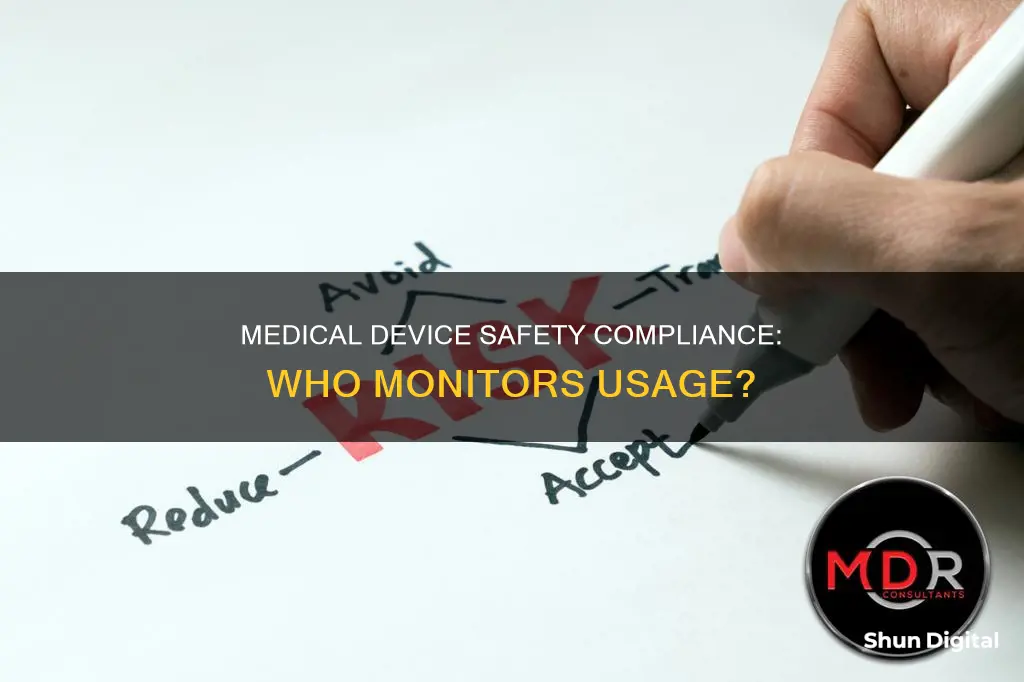
Medical devices are crucial for the safe and effective prevention, diagnosis, treatment, and rehabilitation of diseases and illnesses. They are also essential for achieving health-related Sustainable Development Goals (SDGs). To ensure patient safety, it is important to monitor medical device usage for safety compliance. The World Health Organization (WHO) and the U.S. Food and Drug Administration (FDA) play significant roles in this regard. The WHO provides guidance and standards on the quality, safety, and efficacy of health products, while the FDA regulates firms that manufacture, repackage, relabel, and/or import medical devices sold in the United States. The FDA also monitors reports of adverse events and other problems with medical devices and alerts patients, healthcare providers, and the public when needed. Additionally, the FDA has a Center for Devices and Radiological Health (CDRH) that regulates radiation-emitting electronic products such as lasers, x-ray systems, ultrasound equipment, and microwave ovens.
| Characteristics | Values |
|---|---|
| Organization | FDA (U.S. Food and Drug Administration) |
| Role | The FDA monitors, provides guidance and regulates medical devices to ensure patient safety and effective performance. |
| Medical Device Classification | Class I, II, and III. Regulatory control increases from Class I to Class III. |
| Regulatory Requirements | Establishment registration, medical device listing, premarket notification, premarket approval, investigational device exemption, quality system regulation, labeling requirements, and medical device reporting. |
| Incident Reporting | The FDA monitors reports of adverse events and other problems with medical devices. Manufacturers, importers, device user facilities, health care providers, and patients/caregivers can submit reports. |
| Cybersecurity | The FDA addresses cybersecurity risks and provides recommendations to mitigate threats, working with manufacturers and healthcare delivery organizations. |
| International Collaboration | The FDA collaborates with international organizations such as the International Medical Device Regulators Forum and the Healthcare and Public Health Sector Coordinating Council. |
What You'll Learn
- The FDA monitors medical device safety and issues alerts when necessary
- Medical devices are classified into Class I, II, and III, with regulatory control increasing from Class I to Class III
- The FDA's Center for Devices and Radiological Health (CDRH) regulates firms that manufacture, repackage, relabel, and/or import medical devices in the US
- The FDA issued the Quality Management System Regulation (QMSR) Final Rule, amending the device current good manufacturing practice (CGMP) requirements
- The WHO has a process for reporting incidents related to their recommended medical devices

The FDA monitors medical device safety and issues alerts when necessary
The FDA is responsible for monitoring medical device safety and issuing alerts when necessary. The FDA's Center for Devices and Radiological Health (CDRH) regulates firms that manufacture, repackage, relabel, and/or import medical devices sold in the United States. The CDRH also regulates radiation-emitting electronic products, such as lasers, x-ray systems, ultrasound equipment, microwave ovens, and color televisions.
The FDA classifies medical devices into three classes, with regulatory control increasing from Class I to Class III. Most Class I devices are exempt from Premarket Notification 510(k), while most Class II devices require it, and most Class III devices require Premarket Approval. The FDA also provides a database of product classifications to help manufacturers determine the regulatory requirements for their devices.
In addition to classification requirements, manufacturers of medical devices distributed in the U.S. must comply with basic regulatory requirements, including establishment registration, medical device listing, Premarket Notification 510(k) or Premarket Approval (PMA), Investigational Device Exemption (IDE) for clinical studies, Quality System (QS) regulation, labeling requirements, and Medical Device Reporting (MDR).
The FDA monitors reports of adverse events and other problems with medical devices and issues alerts to patients, health care providers, industry, and the public when needed. The FDA's analyses and recommendations for ongoing medical device safety issues are published as FDA Safety Communications. The FDA also maintains a database of medical device recalls that may present significant risks to consumers or users.
The FDA also addresses cybersecurity in medical devices. As medical devices become increasingly connected to the internet and other networks, they face potential cybersecurity risks that could impact their safety and effectiveness. The FDA provides guidance and resources to help manufacturers, health care providers, and patients address and mitigate these risks.
Monitoring GPU Usage: A Comprehensive Guide to Tracking Performance
You may want to see also

Medical devices are classified into Class I, II, and III, with regulatory control increasing from Class I to Class III
The Food and Drug Administration (FDA) is responsible for monitoring medical device usage for safety compliance. The FDA has established classifications for approximately 1,700 different generic types of devices, which are grouped into 16 medical specialties referred to as panels. Each device is then assigned to one of three regulatory classes: Class I, Class II, or Class III, based on the level of control necessary to provide reasonable assurance of its safety and effectiveness.
Class I devices are subject to the fewest regulatory requirements as they are deemed to have the lowest risk profile. These devices have minimal contact with patients and a low impact on a patient's overall health. Examples include reusable surgical scalpels and non-electric wheelchairs.
Class II devices are more complicated and present a higher category of risk as they are more likely to come into sustained contact with a patient. This includes devices that come into contact with a patient's cardiovascular system or internal organs, and diagnostic tools. Examples include blood pressure cuffs and blood transfusion kits.
Class III devices pose the highest risk and are subject to the most stringent regulatory control. These devices usually sustain or support life, are implanted, or present a potential unreasonable risk of illness or injury. Examples include high-frequency ventilators, fetal blood sampling monitors, and implanted prosthetics.
As the class of a device increases from Class I to Class III, the regulatory controls also increase. Class I devices are subject to general controls, while Class II devices are subject to both general and special controls. Class III devices have the most intensive regulatory requirements, needing to comply with general controls and undergo the Premarket Approval (PMA) process.
The FDA monitors reports of adverse events and other problems with medical devices and alerts patients, healthcare providers, and the public when needed. Manufacturers must also report any incidents related to FDA-recommended medical devices.

The FDA's Center for Devices and Radiological Health (CDRH) regulates firms that manufacture, repackage, relabel, and/or import medical devices in the US
The FDA's Center for Devices and Radiological Health (CDRH) is responsible for regulating firms that manufacture, repackage, relabel, and/or import medical devices in the US. The CDRH's mission is to protect and promote public health by ensuring timely and continued access to safe, effective, and high-quality medical devices and radiation-emitting products. They provide consumers, patients, caregivers, and healthcare providers with understandable and accessible science-based information about the products they oversee.
The CDRH plays a crucial role in facilitating medical device innovation. They achieve this by advancing regulatory science, providing the industry with predictable, consistent, transparent, and efficient regulatory pathways, and assuring consumer confidence in devices marketed in the United States. The center seeks to improve its effectiveness by strategically planning and regularly monitoring its progress.
The CDRH classifies medical devices into three categories with distinct regulatory requirements: Class 1, Class 2, and Class 3. Class 1 devices include low-risk, everyday items such as toothbrushes, which are unlikely to cause serious harm if they malfunction. Manufacturers of these devices must adhere to "general controls" that closely align with ISO 9000 requirements.
Class 2 devices, or "medium-risk" devices, require a premarket notification, commonly known as the "510(k)" process. This process involves demonstrating substantial equivalence to existing devices, and it is intended for new manufacturers of devices that were already on the market when the regulations were established.
Class 3 devices are high-risk products, such as pacemakers, which would pose a significant risk of injury or death if they malfunction. These devices necessitate a rigorous "Pre-market Approval" (PMA) process, analogous to drug approval, which includes clinical trials and extensive design reviews.
The CDRH also oversees the radiation safety performance of non-medical devices that emit certain types of electromagnetic radiation, such as cell phones and microwave ovens. This oversight extends to ensuring the safe and efficacious use of ionizing and non-ionizing radiation-emitting electronic products.
The FDA actively monitors reports of adverse events and other issues with medical devices. When necessary, they issue safety communications and alerts to patients, healthcare providers, the industry, and the public. This proactive approach helps ensure patient safety and maintain the proper functioning of medical devices.

The FDA issued the Quality Management System Regulation (QMSR) Final Rule, amending the device current good manufacturing practice (CGMP) requirements
The FDA monitors reports of adverse events and other problems with medical devices and alerts patients, healthcare providers, industry, and the public when needed. The FDA also monitors reports of cybersecurity issues with devices as part of its surveillance of medical devices on the market.
On January 31, 2024, the FDA issued the Quality Management System Regulation (QMSR) Final Rule, amending the device current good manufacturing practice (CGMP) requirements of the Quality System (QS) Regulation under 21 CFR 820. This rule incorporates by reference the quality management system requirements of the international standard specific for medical device quality management systems set by the International Organization for Standardization (ISO), ISO 13485:2016. The FDA determined that the requirements in ISO 13485 are, when taken in totality, substantially similar to the requirements of the QS regulation, providing a similar level of assurance in a firm's quality management system and ability to consistently manufacture devices that are safe and effective.
The rule amends the title of the regulation and establishes additional requirements that clarify certain expectations and certain concepts used in ISO 13485. These additions ensure that the incorporation of ISO 13485 by reference does not create inconsistencies with other applicable FDA requirements. The FDA also made conforming edits to part 4 (21 CFR part 4) to clarify the device Quality Management System (QMS) requirements for combination products. These edits do not impact the CGMP requirements for combination products.
This action is part of the FDA's efforts to align its regulatory framework with that used by other regulatory authorities to promote consistency in the regulation of devices and provide timelier introduction of safe, effective, and high-quality devices for patients. The rule will be effective on February 2, 2026, two years after its publication. Until then, manufacturers are required to comply with the QS regulation.

The WHO has a process for reporting incidents related to their recommended medical devices
The World Health Organization (WHO) has a process for reporting incidents related to their recommended medical devices. This process is outlined in the "User Feedback Form" and the "Manufacturer Investigation Reporting Form", which can be found on the WHO website. These forms are to be submitted to the email address rapidalert@who.int in the event of any problems or adverse events related to WHO-recommended medical devices, including in vitro diagnostics (IVDs).
The WHO requires that incident reports be submitted for products in the following categories:
- WHO emergency use listed (COVID-19, Zika Virus Disease, Ebola Virus Disease)
- Global Fund/Unitaid expert review panel listed
- Recommended by a WHO technical unit for procurement by WHO
Incident reporting is a crucial aspect of medical device safety and regulation. It allows the WHO to monitor devices and ensure they meet safety standards, reducing the risk of harm to patients and users. Both users and manufacturers play a vital role in this process by promptly reporting any issues or adverse events associated with WHO-recommended medical devices.
The process of incident reporting involves the following key steps:
- Identification of the incident: This includes becoming aware of information regarding an incident, such as device testing results, user feedback, or trends from previous similar incidents.
- Assessment of the link between the device and the incident: This involves considering the opinions of health professionals, user feedback, and any other relevant information.
- Determination of reportability: If the incident meets the defined criteria, including death or serious deterioration in health, it must be reported within the specified time frames.
- Submission of a preliminary report: This report informs WHO that an investigation into the incident has begun and includes basic information about the device, the incident, and the reporter.
- Submission of a final report: This report provides the results and conclusions of the investigation, along with details of any corrective and preventive actions taken.
It is important to note that incidents involving medical devices can have complex causes, and reporters should seek to provide as much relevant information as possible to aid in the evaluation and resolution of the issue. This includes information about the device, the user, the incident itself, and any actions taken.
By following this process, the WHO can effectively monitor and address incidents related to their recommended medical devices, ensuring the safety and well-being of patients and users worldwide.
Frequently asked questions
The FDA's Center for Devices and Radiological Health (CDRH) is responsible for monitoring medical device safety.
Medical device safety monitoring aims to identify and address any safety issues or adverse events associated with the use of medical devices to protect public health.
The basic regulatory requirements for medical devices in the US include establishment registration, medical device listing, premarket notification or approval, investigational device exemption, quality system regulation, labeling requirements, and medical device reporting.
Incidents involving medical devices that result in death or serious injury must be reported to the FDA under the Medical Device Reporting program. Manufacturers, importers, and device user facilities are required to report such incidents.
The CDRH regulates firms that manufacture, repackage, relabel, or import medical devices sold in the United States. They also regulate radiation-emitting electronic products, such as lasers, x-ray systems, and ultrasound equipment.







